Vitamin B12 Supplementation During Pregnancy Influences Metabolic Factors in Male Sprague-Dawley Rat Offspring
| Received 15 Apr, 2024 |
Accepted 15 May, 2024 |
Published 17 May, 2024 |
Background and Objective: Maternal B12 supplementation during pregnancy may have a significant impact on the health of the offspring, especially with regard to metabolic factors in male Sprague-Dawley rat offspring. This is because rats are a useful model for examining the effects of maternal nutrition, providing information on long-term health outcomes. This research explored the effects of perinatal vitamin B12 supplementation on glucose metabolism and adiponectin release in male Sprague-Dawley rat offspring.Materials and Methods: Pregnant rats were divided into 4 groups: Normal or vitamin B12-enriched diets during pregnancy (PG), lactation (PGL), or both (PGL+), compared to control groups. Glucose tolerance, insulin resistance, fasting plasma glucose (FPG), fasting serum insulin concentration (FSI), lipids, body weight and food consumption were evaluated in male offspring at postnatal week 10. Also, lipid profile indices such as total cholesterol (T-CHOL), triglycerides (TG), low-density lipoprotein cholesterol (LDL-C) and high-density lipoprotein cholesterol (HDL-C) were assayed. Results: Perinatal vitamin B12 supplementation didn’t affect maternal weight or food intake. However, PGL+offspring had higher birth weights and both PGL and PGL+groups showed a significant increase (p<0.05) in weight at week 10. Notably, supplemented groups had significantly (p<0.05) lower FPG, FSI, T-CHOL, TG, HDL-C and LDL-C levels and significantly (p<0.05) higher adiponectin levels. Conclusion: Early-life vitamin B12 supplementation positively impacted metabolic parameters and adiponectin release in male Sprague-Dawley rat offspring, emphasizing early interventions for metabolic diseases.
| Copyright © 2024 Dimeji et al. This is an open-access article distributed under the Creative Commons Attribution License, which permits unrestricted use, distribution, and reproduction in any medium, provided the original work is properly cited. |
INTRODUCTION
Pregnancy-related adverse circumstances are linked to chronic metabolic illnesses, specifically obesity, insulin resistance and type 2 diabetes1. The theory of developmental programming was derived from observations made in both human and animal studies. It implies that foetal development issues could have physiological repercussions on an adult’s body that endure a lifetime2.
Numerous investigations have demonstrated the impact of foetal and early postnatal nutrition on subsequent homeostatic mechanisms. Reverse programming, a phenomenon well-documented to heighten the risk of metabolic disorders like insulin resistance, diabetes mellitus and obesity in adulthood, has been widely studied3.
Alterations in dietary habits and lifestyle during early adulthood are associated with an increased risk of chronic diseases. While the idea that the intrauterine environment can influence foetal development is not new, the recent resurgence of interest lies in the concept that foetal development can influence disease in adulthood. Foetal Intrauterine Growth Restriction (IUGR), a consequence of maternal malnutrition, occurs in humans. The foetus’s developmental plasticity enables it to adapt its tissue structure in response to environmental changes and the long-term postnatal effects are described as metabolic imprinting and programming4. Programming refers to any developmental situation where an insult or stimulus results in a permanent physiological change. Within the developmental origins of health and disease field, an established association links small birth size to the risk of chronic disease in adulthood and old age5.
Vitamin B12, a water-soluble vitamin, is vital for erythropoiesis, neural function, DNA synthesis and carbon metabolism6. Its deficiency increases plasma homocysteine levels, an indepedent risk factor for recurrent early spontaneous abortion7. Singh et al.8 found that maternal periconceptional vitamin B12 deficiency in Wistar rats resulted in sex-specific cardiometabolic disease risk. Deficiencies in vitamin B12 and/or vitamin B9 (folate) impact foetal growth and differentiation through the regulation of DNA methylation at various gene loci9. Vitamin B12 and folate, crucial in the one-carbon metabolic (OCM) pathway, influence foetal programming, with folate carrying methyl groups for nucleotide biosynthesis and vitamin B12 serving as a methionine synthase cofactor, converting homocysteine to methionine.
The low serum vitamin B12 concentrations during pregnancy are prevalent due to heightened demand and severe deficiency is associated with adverse pregnancy outcomes. Earlier studies demonstrated that a 90% reduction in plasma vitamin B12 in female Wistar rats is linked to insulin resistance, adiposity, oxidative stress and increased gluconeogenesis in male offspring10. Administering folate and vitamin B12 at an early stage showed some improvement in insulin resistance and lipid levels in IUGR rats, leading to a reduction in homocysteine levels, although these improvements were not sufficient to fully restore glucose and lipid metabolism11.
The rationale for this study is rooted in the critical role of vitamin B12 in the perinatal period and its influence on the long-term metabolic health of offspring. Limited research has specifically explored the effects of perinatal vitamin B12 supplementation on glucometabolic parameters and adiponectin release in male offspring. Considering the rising prevalence of metabolic disorders, investigating the potential preventive effects of vitamin B12 supplementation during this crucial developmental phase may offer valuable insights for interventions aiming to reduce the risk of metabolic disorders later in life.
It is therefore hypothesized that perinatal vitamin B12 supplementation in Sprague-Dawley rats positively affects glucometabolic parameters and increases adiponectin release in male offspring. Furthermore, it is expected that supplementation improves insulin sensitivity, lipid profiles and adiponectin levels, contributing to a healthier metabolic phenotype in male offspring. The study aims to evaluate the impact of perinatal vitamin B12 supplementation on glucometabolic parameters, including insulin sensitivity, glucose tolerance and lipid metabolism markers in male Sprague-Dawley rat offspring. Additionally, it seeks to investigate the influence of perinatal vitamin B12 supplementation on adiponectin release in male offspring, explore potential associations with changes in glucometabolic parameters and examine the long-term effects on the overall metabolic health of male offspring, with a focus on factors such as body weight and adiposity. This research aims to provide valuable insights for preventing adverse metabolic outcomes and informing future strategies to enhance early nutrition, thereby reducing the risk of metabolic disorders in adulthood.
MATERIALS AND METHODS
Study area: The study was conducted between January, to April, 2022 at the Department of Science Laboratory Technology, D.S Adegbenro ICT Polytechnic, Eruku-Itori, Ewekoro, Ogun State, Nigeria.
Diet: Vitamin B12 supplement with NAFDAC number: 04-7011 was purchased from Idi-Araba, a pharmaceutical company in Lagos. The dose of vitamin B12 was 25 mg/kg b.wt.
Experimental animals: Female Sprague-Dawley rats (totalling 18) and twelve males with a weight range of 120-150 g were acquired from the Department of Physiology at the Faculty of Medicine, University of Lagos. A 2 week acclimatization period preceded the experiments, during which the rats were provided with unrestricted access to normal rodent food and water. The experimental protocols adhered to the guidelines set by the Experimental Ethics Committee on Animal Use of the College of Medicine, University of Lagos, Lagos State. Additionally, the procedures followed the recommendations outlined in the Guide for the Care and Use of Laboratory Animals by the National Academy of Sciences.
Mating and grouping: Female rats were paired with proven male breeders for overnight mating and vaginal swabs were rinsed with normal saline (0.9% w/v NaCl). The collected samples, using a rubber pipette onto a glass slide, were examined for the presence of spermatozoa following the method described by Igbayilola et al.12. Subsequently, pregnant rats were moved to separate cages and randomly allocated to one of four groups thus:
| Group 1: | Control (exposed to only normal rat chow) | ||
| Group 2: | Pregnancy group (exposed to vitamin B12 only during pregnancy) | ||
| Group 3: | Lactation group (exposed to vitamin B12 only during lactation) | ||
| Group 4: | Pregnancy and Lactation group (exposed to vitamin B12 both during pregnancy and lactation) |
Measurement of body weight changes: Animals were weighed at birth and recorded weekly using a Duet top-loading scale (Salter, England).
Determination of oral glucose tolerance: The pups underwent an overnight fasting period prior to the examination. At the reference time (zero-min glucose), a blood sample was obtained. This baseline blood sample was referred to as zero-min glucose. Subsequently, each rat was administered an oral glucose load of 2 g/kg b.wt., using a glucose solution (D-(+) glucose 99.5%; Sigma product). The blood samples were then collected from the tail vein at specific intervals of 30, 60, 120 and 180 min following the glucose challenge. The measurement of glucose levels was conducted using an Acu-chek glucometer along with glucose strips.
Determination of insulin tolerance: The pups underwent an overnight fast, following the procedure outlined for glucose tolerance testing. Subsequently, an intraperitoneal administration of an insulin bolus at 0.75 IU/kg b.wt., was carried out and blood glucose levels were measured at multiple time points within a 120 min time frame.
Blood collection: Blood samples, each comprising 4 mL, were obtained through retro-orbital puncture in pups following a brief anesthesia with isoflurane (5% for 2 min), as detailed by Igbayilola et al.12. The collected blood was allowed to coagulate at 4°C for 1 hr and then subjected to centrifugation at 3000×g for 10 min. Using a rubber pipette, serum samples were meticulously separated from the whole blood, transferred into clean Eppendorf bottles and subsequently stored at -20°C until further analysis, following the protocol described by Morakinyo et al.13.
Determination of plasma glucose level: The glucose oxidase-peroxidase method was widely used to measure plasma glucose levels during fasting using Abcam glucose kit (UK). First, a blood sample was drawn and centrifugation was used to separate the plasma. Hydrogen peroxide was produced by the oxidation of glucose, which was catalyzed by glucose oxidase. A coloured chemical was produced when hydrogen peroxide and a chromogen interacted in the presence of peroxidase. Using spectrophotometry, the color intensity was proportionate to the glucose concentration. Accuracy was assured by calibration using recognized glucose standards12.
Insulin resistance (IR): The homeostatic model assessment of insulin resistance (HOMA-IR)was determined in pups using the equation below:
The IR was evaluated using the equation below12:
where, FPG is fasting plasma glucose (ng/mL) and FSI is fasting serum insulin (mg/dL).
Measurement of serum insulin: The measurement of fasting serum insulin levels in pups utilized an Enzyme-Linked Immunosorbent Assay (ELISA) test, employing a rat insulin ELISA kit from Elabscience, Wuhan, China. In this procedure, 50 μL of the sample was carefully transferred into an Eppendorf tube and to the appropriately labeled samples, 100 μL of the complex was added. Simultaneously, another Eppendorf tube received 50 μL of the standard, followed by the addition of 100 μL of the conjugate. A blank was prepared and incubated with the standard and sample at room temperature (22-28°C) for 2 hrs, after which the absorbance was measured at 450 nm against the blank.
Assay of adiponectin levels in serum: This parameter was determined in pups using an Enzyme-Linked Immunosorbent Assay (ELISA) rat adiponectin kit (Elabscience Biotechnology Co., China). The procedures specified in the kit manufacturer’s manual were followed.
Lipid profile analysis: Serum total cholesterol (T-CHOL), triglyceride (TG), high-density lipoprotein cholesterol (HDL-C) and low-density lipoprotein cholesterol (LDL-C) levels were assayed in pups using an automated analyzer (Roclie, HITA-CHI).
Statistical analysis: Data were recorded as Mean±Standard error of the mean. Statistical differences between means were determined by one-way analysis of variance. Tukey’s post hoc test was used to identify differences between individual means. Confidence intervals were set at 95% and results with a value of p<0.05 were accepted as significant in all cases (Graph Pad Prism 5, Graph Pad Software, Inc., La Jolla, California, USA).
RESULTS
Table 1 shows the fertility of pregnant female rats in control and vitamin B12 supplemented rats.
Body weight changes: Table 2 shows blood glucose levels in offspring exposed to vitamin B12 during pregnancy and/or lactation. At birth (week 0), offspring supplemented with Vitamin B12 experienced greater weight gain compared to controls (p<0.05) and groups 2, 3 and 4 offspring gained significantly more weight at week 10. (p<0.05). Body weight was significantly reduced in group 4 compared to groups 3 and 4 (p<0.05).
Fasting serum glucose:
Figure 1 shows fasting plasma glucose (FPG) levels in offspring exposed to vitamin B12 during pregnancy and/or lactation and this revealed a significant decrease (p<0.05) in FPG in groups 2 and 3 compared with control and a significant decrease (p<0.05) in group 2 compared with group 4.
Oral glucose tolerance test: Figure 2 shows blood glucose levels in offspring exposed to vitamin B12 during pregnancy and/or lactation during OGTT. At 30 min, glucose levels were significantly lower in group 2 compared to controls (p<0.05) and significantly higher in group 3 compared to controls. After 60 min, blood glucose levels were significantly lower in group 2 and significantly higher in both groups 3 and 4 than controls (p<0.05). After 120 min, blood glucose levels were significantly higher in 3 and 4 compared to controls (p<0.05). The results are shown in Fig. 2.
Insulin tolerance test (ITT):
Figure 3 shows blood glucose levels in offspring exposed to vitamin B12 during pregnancy and/or lactation. The results revealed that the blood glucose levels at 30, 60, 90 and 120 min during ITT were significantly decreased in groups 2, 3 and 4 compared to control (p<0.05).
Serum levels of T-CHOL, TG, LDL-C and HDL-C: Table 3 shows serum T-CHOL, TG, LDL-C and HDL-C levels in offspring exposed to vitamin B12 during pregnancy and/or lactation and this displayed a significant decrease (p<0.05) in T-CHOL, TG and LDL-C levels in groups 2, 3 and 4 compared with control. Increased (p>0.05) in groups 2 and 3 but only significant (p<0.05) in group 4 compared with control and significantly increased (p<0.05) in group 4 compared with groups 2 and 3.
| Table 1: | Fertility of female Dams fed the vitamin B12 supplemented diet | |||
| Parameter | Group 1 | Group 2 | Group 3 | Group 4 |
| Conception (%) | 99 | 67 | 86 | 90.5 |
| Stillbirth (%) | 0 | 0 | 0 | 0 |
| Average litter size (n) | 8 | 9 | 10 | 11 |
| Weight gain during pregnancy (g) | 169.75±4.1 | 172.38±5.2 | 175.78±5.3 | 177.34±5.42 |
| Medium weaning weight | 36.00±1.6 | 39.66±2.3 | 40.1±0.3 | 40.8±0.2 |
| Pre-weaning mortality rate (n) | 4 | 3 | 2 | 3 |
| Table 2: | Weight changes in offspring exposed to vitamin B12 diet during pregnancy and/ or lactation | |||
| Group | IW | FW | WC |
| Group 1 | 2.00±0.20 | 66.00±3.30 | 64.25±2.56 |
| Group 2 | 3.96±0.25# | 63.30±2.30 | 59.40±3.01# |
| Group 3 | 4.10±0.40# | 88.30±3.90# | 84.30±2.80#a |
| Group 4 | 4.25±0.16# | 54.66±3.48#a1 | 50.41±2.03#a1 |
| Values represent mean±SEM. Significant values, (#p<0.05 vs. cont, ap<0.05 vs. group 2 1p<0.05 vs. group 3). IW: Initial weight, FW: Final weight and WC: Weight changes | |||
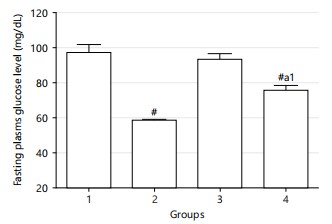
|
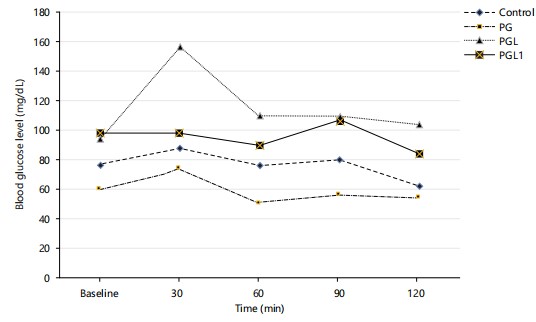
|
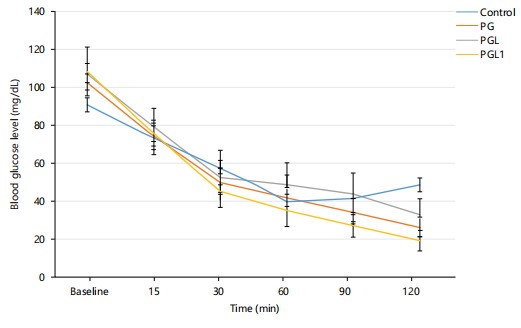
|
| Table 3: | T-CHOL, TG, HDL-C and LDL-C in offspring exposed to vitamin B12 diet during pregnancy and/or lactation | |||
| Parameter (mmol/dL) | Group 1 | Group 2 | Group 3 | Group 4 |
| T-CHOL | 3.55±0.43 | 3.24±0.3 | 2.95±0.13# | 2.97±0.1# |
| TG | 2.46±0.15 | 1.30±0.3# | 1.70±0.1#a | 1.48±0.2#1 |
| HDL-C | 1.41±0.11 | 1.58±0.1 | 1.44±0.1 | 2.08±0.3 #a1 |
| LDL-C | 1.16±0.34 | 0.64±0.2# | 0.91±0.1# | 0.70±0.2# |
| Values represent Mean±SEM. Significant values (#p<0.05 vs. cont, ap<0.05 vs. group 2, 1p<0.05 vs. group 3) | ||||
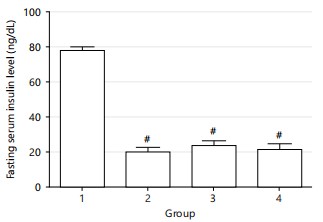
|

|
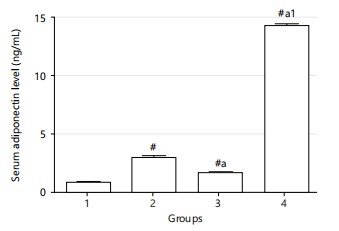
|
Fasting serum insulin (FSI) level: Figure 4 shows fasting serum insulin levels in offspring exposed to vitamin B12 during pregnancy and/or lactation and this significantly decreased in groups 2, 3 and 4 compared to controls (p<0.05).
Homeostatic model assessment of insulin resistance (HOMA-IR): Figure 5 shows HOMA-IR in offspring exposed to vitamin B12 during pregnancy and/or lactation and this was significantly decreased in groups 2, 3 and 4 compared to control (p<0.05).
Fasting serum adiponectin: Figure 6 shows fasting serum adiponectin levels in offspring exposed to vitamin B12 during pregnancy and/or lactation and the results were significantly increased in groups 2, 3 and 4 compared to control (p<0.05) and significantly decreased in group 3 compared to group 2 (p<0.0) and significantly increased in group 4 compared to groups 2 and 3.
DISCUSSION
This study shows that the body weight of the foetus may be impacted by the mother’s vitamin B12 dosage during pregnancy. This showed that when a mother consumes a suitable amount of vitamin B12, normal birth weight in her offspring is associated with optimal foetal growth and development. Conversely, a mother’s B12 insufficiency has been linked to low birth weight and intrauterine growth limitation. Furthermore, recent studies suggest that mother B12 supplementation may lower the risk of obesity in offspring via regulating adiposity and metabolic pathways.
Birth size is a reliable indicator of both infant development and viability, closely linked to lifelong health consequences14. Infants with low birth weight are more susceptible to chronic conditions in later life, including obesity, cardiovascular disease, type 2 diabetes and certain cancers1. Increased body weight is associated with elevated food consumption, aligning with a previous rat model study on perinatal vitamin B12 supplementation and its impact on offspring glucose metabolism15. In line with Lawlor et al.15, this study observed a progressive increase in body weight and Finkelstein et al.16 found improved glucose tolerance and insulin sensitivity in male offspring with vitamin B12 supplementation during pregnancy and lactation. These results suggested that adequate perinatal vitamin B12 levels may enhance glucose metabolism in male offspring.
Glucose metabolism indicators, including fasting serum glucose, OGTT, ITT and fasting serum insulin, were measured. Offspring receiving vitamin B12 supplementation during pregnancy and lactation exhibited a significant increase in blood glucose levels during oral glucose tolerance testing, indicating improved glucose tolerance. This implies that vitamin B12 supplementation before and after birth may enhance glucose tolerance in rat offspring, consistent with Kumar et al.17. The study also demonstrated a significant reduction in blood glucose levels during ITT, suggesting improved insulin sensitivity, in agreement with Kumar et al.17. Decreases in fasting serum glucose and fasting serum insulin levels in offspring exposed to vitamin B12 during pregnancy, lactation, or both suggest a role for vitamin B12 supplementation in enhancing glucose tolerance and insulin sensitivity.
The study examined the effect of perinatal vitamin B12 supplementation on the lipid profile of male offspring in Sprague-Dawley rats. Current study findings showed a significant effect on lipid parameters, suggesting a possible role of vitamin B12 in the perinatal period. According to Schmidt et al.14 study results, previous studies have emphasized the importance of maternal nutrition in influencing offspring health. Maternal vitamin B12 supplementation has been associated with various developmental benefits and currentstudy extends this understanding to include lipid metabolism in male offspring. The observed changes in lipid profile parameters such as total cholesterol, triglycerides and low-density lipoprotein cholesterol (LDL-C) indicate a possible regulatory role of vitamin B12 in the perinatal period. These findings were consistent with new research suggesting that early nutritional interventions can have lasting effects on metabolic health11. Although, the specific mechanisms underlying these effects remain to be elucidated, it is likely that vitamin B12, a cofactor in several metabolic pathways, plays a role in the regulation of lipid metabolism.
Adiponectin is a hormone generated from adipocytes that has anti-inflammatory and cardioprotective properties. It is linked to insulin sensitivity and metabolic balance18,19. Low adiponectin levels are associated with insulin resistance and an increased risk of type 2 diabetes. Perinatal vitamin B12 supplementation, as observed by Boachi et al.20 increased adiponectin levels in male offspring, indicating potential beneficial effects on glucose metabolism through modulating adiponectin release. Unlike leptin, plasma adiponectin levels are negatively correlated with body fat. The significant increase in adiponectin levels in all offspring exposed to vitamin B12 was associated with increased fat in adipocytes, suggesting a complex relationship. The mechanisms behind these effects, including potential epigenetic modifications like DNA methylation, remain an active area of research21.
The study underscores the importance of maternal nutrition, particularly Vitamin B12 supplementation, during pregnancy. It highlights the potential implications of maternal B12 deficiency on offspring health outcomes, emphasizing the need for awareness and intervention strategies to optimize maternal nutrition. Understanding the influence of maternal B12 supplementation on offspring health provides valuable insights into the long-term consequences of early nutritional interventions. This knowledge can inform public health policies aimed at promoting maternal and offspring health across generations. The findings suggest that maternal Vitamin B12 supplementation may have preventive effects against metabolic disorders such as obesity, dyslipidemia, insulin resistance and type 2 diabetes in offspring. Implementing strategies to ensure adequate B12 intake during pregnancy could contribute to reducing the burden of these diseases.
Healthcare providers can integrate recommendations for vitamin B12 supplementation into prenatal care protocols to support maternal and offspring health. Screening for B12 deficiency during pregnancy and providing appropriate supplementation can be crucial in preventing adverse outcomes in offspring. The study underscores the potential role of nutritional interventions, including B12 supplementation, in mitigating the risk of metabolic disorders in offspring. Targeted interventions aimed at optimizing maternal nutrition can be implemented to improve offspring health outcomes. National and international health organizations can develop guidelines for vitamin B12 supplementation during pregnancy based on the study findings. These guidelines can provide recommendations for optimal B12 intake levels and supplementation strategies to support maternal and offspring health.
Public health campaigns aimed at promoting maternal nutrition awareness can include information on the importance of Vitamin B12 during pregnancy. Educating women of childbearing age and healthcare providers about the role of B12 supplementation in offspring health can help increase adherence to recommended guidelines. The study’s findings are based on animal models, particularly male Sprague-Dawley rats, which may not fully translate to human populations. Further research using human cohorts is needed to confirm the relevance of these findings in clinical settings. Maternal nutrition involves a complex interplay of various nutrients and environmental factors, which may confound the effects of Vitamin B12 supplementation. Future studies should consider these interactions to provide a more comprehensive understanding of maternal nutrition’s impact on offspring health.
While the study examines the immediate effects of maternal B12 supplementation on offspring health, long-term follow-up studies are needed to assess the persistence of these effects into adulthood. Understanding the lifelong implications of early nutritional interventions is essential for informing preventive strategies against metabolic disorders and other health conditions.
CONCLUSION
Our study of perinatal vitamin B12 supplementation in male Sprague-Dawley rats provides promising insights into the potential benefits of early nutritional interventions. Findings suggest that such supplementation can positively affect insulin sensitivity, glucose tolerance and lipid metabolism, leading to increased adiponectin release, indicating improved adipose tissue function and insulin sensitivity. These findings have implications beyond the perinatal period and affect the metabolic health of the offspring throughout life. The potential to mitigate the risks of metabolic disorders such as obesity and type 2 diabetes underscores the importance of researching nutritional strategies during critical developmental windows. Although the results are promising, further studies are needed to understand the underlying molecular mechanisms and confirm long-term sustainability. Extrapolation of these findings to human populations requires careful consideration of species-specific variation and confounding factors. Our study contributes to increasing knowledge about perinatal nutrition and metabolic programming and supports targeted intervention to improve lifelong metabolic resilience.
SIGNIFICANCE STATEMENT
Because it examines a crucial but little-researched topic-the impact of maternal B12 supplementation on offspring’s metabolism-this work is extremely important. Gaining insight into these impacts may help identify possible treatments for metabolic diseases. The results might clarify the long-term health effects on progeny and guide the treatment of mothers. This study fills a knowledge gap and may provide solutions for preventing metabolic disorders. In the end, it emphasizes how important maternal diet is in determining the health of her offspring.
ACKNOWLEDGEMENT
We would like to acknowledge Mr. Sunday Ogunowo of the Lagos University Main Laboratory of the College of Medicine, University of Lagos for the technical support.
REFERENCES
- Barker, D.J., A.R. Bull, C. Osmond and S.J. Simmonds, 1990. Fetal and placental size and risk of hypertension in adult life. Br. Med. J., 301: 259-262.
- Kapoor, A., E. Dunn, A. Kostaki, M.H. Andrews and S.G. Matthews, 2006. Fetal programming of hypothalamo-pituitary-adrenal function: Prenatal stress and glucocorticoids. J. Physiol., 572: 31-44.
- Adair, L.S., C.W. Kuzawa and J. Borja, 2001. Maternal energy stores and diet composition during pregnancy program adolescent blood pressure. Circulation, 104: 1034-1039.
- Waterland, R.A. and R.L. Jirtle, 2003. Transposable elements: Targets for early nutritional effects on epigenetic gene regulation. Mol. Cell. Biol., 23: 5293-5300.
- Allen, L.H., 2001. Biological mechanisms that might underlie iron's effects on fetal growth and preterm birth. J. Nutr., 131: 581S-589S.
- Green, R. and J.W. Miller, 2005. Vitamin B12 deficiency is the dominant nutritional cause of hyperhomocysteinemia in a folic acid-fortified population. Clin. Chem. Lab. Med., 43: 1048-1051.
- Nelen, W.L.D.M., H.J. Blom, E.A.P. Steegers, M. den Heijer, C.M.G. Thomas and T.K.A.B. Eskes, 2000. Homocysteine and folate levels as risk factors for recurrent early pregnancy loss. Obstet. Gynecology, 95: 519-524.
- Singh, P., L. Kaur, S. Ghose, S. Varshney and V. Jyothi et al., 2023. Maternal-periconceptional vitamin B12 deficiency in Wistar rats leads to sex-specific programming for cardiometabolic disease risk in the next generation. J. Nutr., 153: 3382-3396.
- Mahajan, A., D. Sapehia, S. Thakur, P.S. Mohanraj, R. Bagga and J. Kaur, 2019. Effect of imbalance in folate and vitamin B12 in maternal/parental diet on global methylation and regulatory miRNAs. Sci. Rep., 9.
- Kumar, K.A., A. Lalitha, U. Reddy, G.R. Chandak, S. Sengupta and M. Raghunath, 2014. Chronic maternal vitamin B12 restriction induced changes in body composition & glucose metabolism in the Wistar rat offspring are partly correctable by rehabilitation. PLoS ONE, 9.
- Zhang, H., X. Wang, J. Zhang, Y. Guan and Y. Xing, 2022. Early supplementation of folate and vitamin B12 improves insulin resistance in intrauterine growth retardation rats. Transl. Pediatr., 11: 466-473.
- Igbayilola, Y.D., A.O. Morakinyo and B.O. Iranloye, 2021. Adverse effects of perinatal protein restriction on glucose homeostasis in offspring of Sprague-Dawley rats. Sci. Afr., 14.
- Morakinyo, A.O., B.O. Iranloye and O.A. Ogunsola, 2018. Glucometabolic effects of single and repeated exposure to forced-swimming stressor in sprague-dawley rats. Endocr. Regulations, 52: 85-92.
- Calkins, K. and S.U. Devaskar, 2011. Fetal origins of adult disease. Curr. Probl. Pediatr. Adolesc. Health Care, 41: 158-176.
- Lawlor, D.A., G.D. Smith and S. Ebrahim, 2002. Birth weight of offspring and insulin resistance in late adulthood: Cross sectional survey. BMJ, 325.
- Finkelstein, J.L., A. Fothergill, S. Venkatramanan, A.J. Layden, J.L. Williams, K.S. Crider and Y.P. Qi, 2024. Vitamin B12 supplementation during pregnancy for maternal and child health outcomes. Cochrane Database Syst. Rev., 1.
- Kumar, K.A., A. Lalitha, D. Pavithra, I.J.N. Padmavathi and M. Ganeshan et al., 2013. Maternal dietary folate and/or vitamin B12 restrictions alter body composition (adiposity) and lipid metabolism in Wistar rat offspring. J. Nutr. Biochem., 24: 25-31.
- Scherer, P.E., S. Williams, M. Fogliano, G. Baldini and H.F. Lodish, 1995. A novel serum protein similar to C1q, produced exclusively in adipocytes. J. Biol. Chem., 27: 26746-26749.
- Yamauchi, T., J. Kamon, H. Waki, Y. Terauchi and N. Kubota et al., 2001. The fat-derived hormone adiponectin reverses insulin resistance associated with both lipoatrophy and obesity. Nat. Med., 7: 941-946.
- Boachie, J., V. Zammit, P. Saravanan and A. Adaikalakoteswari, 2023. Metformin inefficiency to lower lipids in vitamin B12 deficient HepG2 cells is alleviated via adiponectin-AMPK axis. Nutrients, 15.
- Lillycrop, K.A. and G.C. Burdge, 2011. Epigenetic changes in early life and future risk of obesity. Int. J. Obesity, 35: 72-83.
How to Cite this paper?
APA-7 Style
Dimeji,
I.Y., Adeoye,
S.W., Gujja,
G.M. (2024). Vitamin B12 Supplementation During Pregnancy Influences Metabolic Factors in Male Sprague-Dawley Rat Offspring. Trends in Medical Research, 19(1), 92-102. https://doi.org/10.3923/tmr.2024.91.101
ACS Style
Dimeji,
I.Y.; Adeoye,
S.W.; Gujja,
G.M. Vitamin B12 Supplementation During Pregnancy Influences Metabolic Factors in Male Sprague-Dawley Rat Offspring. Trends Med. Res 2024, 19, 92-102. https://doi.org/10.3923/tmr.2024.91.101
AMA Style
Dimeji
IY, Adeoye
SW, Gujja
GM. Vitamin B12 Supplementation During Pregnancy Influences Metabolic Factors in Male Sprague-Dawley Rat Offspring. Trends in Medical Research. 2024; 19(1): 92-102. https://doi.org/10.3923/tmr.2024.91.101
Chicago/Turabian Style
Dimeji, Igbayilola, Yusuff, Saka Waidi Adeoye, and Grema Mariam Gujja.
2024. "Vitamin B12 Supplementation During Pregnancy Influences Metabolic Factors in Male Sprague-Dawley Rat Offspring" Trends in Medical Research 19, no. 1: 92-102. https://doi.org/10.3923/tmr.2024.91.101

This work is licensed under a Creative Commons Attribution 4.0 International License.

